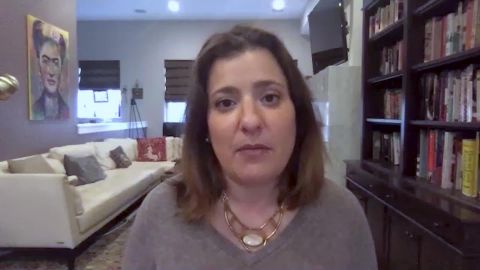Read Transcript EXPAND
CHRISTIANE AMANPOUR: Even before the coronavirus outbreak, many college students in the United States struggled to balance schoolwork and keeping a roof over with their heads and food on their plates, and they now find themselves in an even tougher situation. Sara Goldrick-Rab is a professor of higher education, policy and sociology at Temple University in Philadelphia. And she’s best known for her groundbreaking work to combat food and housing insecurity. And she talks with our Hari Sreenivasan about what needs to be done for this vulnerable group right now.
(BEGIN VIDEOTAPE)
HARI SREENIVASAN: Sara, we have spoken before about the food insecurity, about housing insecurity that college students are going through, and that was before the pandemic. That was before a shutdown that’s taking all of these kids off campus. So let’s kind of unpack what students are going through now. How much worse does it become?
SARA GOLDRICK-RAB, TEMPLE UNIVERSITY: Well, I think it’s become even more difficult. The challenges that they were facing before, issues like food insecurity, that came from a lack of money and a difficulty paying their bills. And now, thanks to this pandemic, many of them have lost their jobs or at least seen their hours cut. And, also, things that they paid for already, things like their meal plans, they can’t use them anymore. While their colleges say that they’re going to maybe refund some of the money, it’s not going to come right away. So I honestly think that it’s pretty likely that larger numbers of them are dealing with these challenges now.
SREENIVASAN: Outline some of the challenges that college students were already facing.
GOLDRICK-RAB: Before this pandemic, my team spent five years doing surveys of college students around the country, focused mainly on the public sector. Public higher education enrolls three out of four college students. And our surveys added up to over 330,000 students across 400-plus colleges and universities. In February, we issued a report. So this is before the pandemic. Our report documented that 43 percent of those 330,000 students, 33 percent of them had experienced food insecurity while they were in college; 48 percent had experienced housing insecurity, and 16 percent had experienced homelessness in the prior year. That was before the pandemic. We can only imagine what that looks like now.
SREENIVASAN: The financial picture that you paint also, a lot of students actually have to have jobs to be able to attend college, whether it’s an on-campus job or off-campus job. And as we have watched over the past several weeks, there’s not a single part of this economy that has been untouched.
GOLDRICK-RAB: Yes. I mean, about 70 percent of college students were working before the pandemic, and an even substantial — even more substantial were involved in the labor force in some way because they were looking for a job, but they could not find one. Now you have all of these people who have been told, we either can’t go to work or my job closed. A lot of people in college work at restaurants,for example, and we have been see what’s happening there. So to be told you still have to pay your rent, and you don’t have money coming in, it really does create a significant crisis. The other thing is, most of these students have no idea what unemployment insurance is. And if they have heard of it, they don’t know how to access it.
SREENIVASAN: What are some of the stories that you have been hearing or even reading? I know you get e-mails from students around the country.
GOLDRICK-RAB: Well, I have been part of a team behind an organization that is running a relief fund called StudentReliefFund.org. And I will share with you — I have a couple of e-mails here that I received. One of them is from California Polytechnic State University at San Luis Obispo. And the student writes: “I lost my on-campus job because of the coronavirus. I use this job to pay for my rent and utilities, and I’m not going to be able to pay my bills. I don’t know what to do because I have independently supported myself on this front all through college. My parents cannot afford to just pay the costs for me.” And another one who was also writing from California, this time from the University of California, Irvine, a top public university, says: “My family doesn’t have money saved for emergency situations like this because we’re a low-income family. We need the money of every check we get. And we’re scared we’re not going to be able to pay for rent and utilities. We’re scared we’re not going to have a roof over our heads. I’m scared that I’m going to have to leave school to work full-time. And I’m just one quarter away from graduating from college.” I mean, the level of terror that some of these folks are feeling is real, because they know, especially if they come from a low-income family, that that college degree is the thing that most likely is going to help them get out of poverty. And now they’re essentially trapped. They’re not going to be able to get it.
SREENIVASAN: So, what is a college supposed to do? What our colleges doing in response?
GOLDRICK-RAB: I’ll tell you, the best colleges right now are, first and foremost, acknowledging the reality of that situation. They’re not trying to pretend that every student who had to leave their institution went home to two parents who are just paying the bills, and the student is sitting around doing a TikTok video, OK? They are saying to their students, we know this is really hard. We know you’re losing your job, we know you’re having trouble with your rent, and we want to connect you to a variety of resources to help you do that. So those folks are talking about things like unemployment insurance, they’re talking about things like SNAP, they’re telling students that they’re going to do their best to get them refunds, and they’re giving them some sense of when it will come if they, for example, prepaid their housing. But that isn’t the majority. The majority of schools seem to say to students, look, we have got to close and you got to get out of here. And they’re even arguing with them over issues of refunds. What I mean is, they’re really not being very sensitive. And as a result of not acknowledging how hard this is for everybody, I don’t know that all the students are going to return to those schools.
SREENIVASAN: A lot of times, especially for first-generation students, it’s already difficult to choose college over supporting your family. And I’m imagining right now there’s some difficult conversations with kids who may be just a quarter away or a semester away from graduating, but the families are calling and saying, hey, all of us have lost our jobs. We need you to pitch in.
GOLDRICK-RAB: Yes, I mean, that’s been going on. The pitching in has been going on for a long time. And it’s one of those untold stories of higher ed in many ways, where we imagine that, if a student runs out of money, it’s because they spent it on pizza, when the truth is, they spent it helping mom keep the lights on for the younger brothers and sisters. Now that problem is going to be exacerbated. And I do expect that some of the educational disruption that we see, some of the leaving college is going to be because, when work does reappear, these students are going to have to work especially long hours to help their families economically recover. Some of these folks are quarantined or locked down right now with those family members. And their college is saying something to them like, we have an online class, and it meets today at 2:00. Well, those folks are trying to manage the younger siblings who are in the house who also are not in school, a similar situation to the 4.3 million college students who have children of their own, who right now are being told, you’re supposed to go to an online class and pay attention when their children are running around.
SREENIVASAN: Is there still a digital divide, a gap here? Because online courses came on really the scene maybe 10 years ago or so. But, at least on the elementary school level, we’re seeing cases where kids from impoverished neighborhoods, they don’t have laptops, they don’t have access to Wi-Fi, they don’t have access to high-speed Internet at home. How are colleges or how are institutions trying to solve for that?
GOLDRICK-RAB: So, look, the situation’s exactly the same in higher education. And, frankly, many of those school-age kids that don’t have broadband access live with an adult, who then doesn’t have broadband access for their college work too. There is a dearth of laptops. There’s a lack of good and strong enough broadband access. And then let’s be off — let’s be honest. If you’re going to do Zoom every day, you actually have to have pretty high-speed Internet, and your laptop actually has to be really high-functioning. Some of these folks, just that’s the part where they fall short. So colleges are trying. I have been watching a lot of community college presidents that are digging deep into their budgets and pulling out the little bit they have and trying to buy Chromebooks and other supplies for their students. But the need far outstrips the amount of money that they have available. As a result, we’re seeing things like community colleges are driving buses around and parking them in parking lots and broadcasting the Wi-Fi, so people can come and sit in the parking lot and supposedly take their class or get online, all kinds of creativity. But let’s be honest. Online education simply isn’t equitable. It’s not equitable in who has access to it. And it isn’t equitable in terms of its quality of teaching people. The people, those first-generation students, all the studies show, learn the least from online education. They really need the in-person. And they’re the ones who are really losing out right now.
SREENIVASAN: What about the faculty that are caught up in this? I mean, we have this notion of faculty being tweed-jacket-wearing, tenured, spectacled folks. Well, that’s not most of them, are they? I mean, they’re also, I’m imagining, in their own households, feeling a big pinch here, because, other than this university job, there’s got to be others that are embedded in their house.
GOLDRICK-RAB: That’s right. I mean, look, the inequality among faculty is extreme, and most people don’t get it. I’m going to be honest with you. I’m a full and tenured professor, and I am not worried about my job security right now. And, as you can see, I have a nice home. I have colleagues, even in my own institution, who are not sure they’re going to have a job next week, who are not living in any kind of nice home. They’re living in an overcrowded apartment with their children. Some of them are living in their cars, OK? So these folks are deeply affected by these challenges. And the really kind of horrible part of all of this is that, when the universities take deeper and deeper budget cuts just to survive, what they’re going to do is hire more and more people under those same working conditions. So they’re going to hire more adjunct faculty and pay them badly. They’re not going to have offices on campus. They’re not going to earn a living wage. And an increasing number of college students are going to be taught by people facing those working conditions. And studies show that does not lead to the same educational outcomes for those students. So, again, this is another way the situation will play itself out repeatedly over time.
SREENIVASAN: What about the stimulus bill that was just passed? Is that going to be enough?
GOLDRICK-RAB: The stimulus bill, it’s tricky. No, it certainly won’t be enough. It won’t be enough for anybody, I mean, whether it’s college student or not. But one of the things I’m concerned with is, it looks like, from the stimulus bill, that if you’re a college student, and your parents claim you as a dependent on their taxes, you’re not going to get a stimulus check, even if the truth is, your parents really don’t provide you with financial support. I know they’re not supposed to claim you as a dependent and not provide you with a substantial amount of financial support, but that happens all the time. And it especially happens to LGBT students who are disproportionately estranged from their parents. So I am really worried that some of the most vulnerable students who are already in tough situations are going to be completely left out of the stimulus bill.
SREENIVASAN: The aid in this package right now is somewhere, what, around $7 billion just for students, right? That’s not going to be enough?
GOLDRICK-RAB: Seven — now, so this — yes, the $7 billion isn’t going to be anywhere near enough, to be perfectly honest with you. It’s going to be — it’s a lot more than we had expected to come. So that’s the starting point. I mean, when Senator Patty Murray put out her bill, and it had $1.2 billion in emergency aid in this, most of us thought that would be a reach. And this is certainly more. But we do need to be honest, as I have been saying, about the gaps that existed even before the pandemic and have now widened. So we cannot pretend like, before the pandemic, there were no financial shortfalls. That’s the problem with the funding amount, is that we have the existing shortfall. Now it got even larger. To make up for those shortfalls would probably be three times that $7 billion.
SREENIVASAN: Even if, let’s say, best-case scenario, we get through this surge, we flatten the curve, how long are the consequences to the higher education system?
GOLDRICK-RAB: I have a hard time believing this is something that we recover from within even a five-year period. You know, the last recession had such lasting implications. It’s more than 10 years out from that recession, and I don’t think that higher ed really recovered. So I am afraid that this is going to be at least 10 years. The only thing that could really change that is if we see federal policy change that helps states and bring states back to the table, so that they begin to reinvest in higher education sooner, rather than later. It’s not just about the implications for higher ed. These effects trickle down. So, for example, if higher education becomes even less affordable because of this pandemic, that will affect how children across America look at their future opportunities. We know that, if you’re a middle-schooler and you don’t think college is in your future, you’re much more likely to get in trouble and much less likely to invest in your education and secondary school. So, I’m concerned that we don’t think about this proactively enough. The other piece we have to think about is, higher education is also an intervention in community health. We have a chance here to ensure the nation’s community colleges in particular do their part in remediating the effects of this pandemic, in helping people become healthier, and in preventing the next one. And those investments are important, but that means reversing the longstanding trend of putting the least amount of resources into the most important colleges.
SREENIVASAN: What’s your sort of optimistic outcome here? I mean, what are the positive things that could happen that you have already been talking about which are necessary for institutions, when, essentially, this pandemic seems like a giant reset button in some ways?
GOLDRICK-RAB: Yes. I mean, look, if we were going to make lemonade out of the situation, what I’d say is, first, to the extent that colleges and universities are now waking up to the reality that their students are first and foremost human beings, and they must have their basic needs addressed before they can learn, if they were to use that in their practice going forward, if they were to approach every incoming student, every returning student first by asking about whether they have enough to eat and a safe place to sleep, and trying to bridge community services to help make that happen, that would be a sea change in higher ed If that also meant that faculty got professional development to help them integrate those lessons into their practice, that would be a sea change. The other thing that I think is promising is, this is the first time that we have really seen the federal government acknowledge that the federal financial aid system is terrible at getting money to people quickly when they need it. They have essentially authorized colleges to deliver money much more rapidly. And that needs to be in all federal policy for higher education moving forward, because there have always been cracks in the financial aid system. It’s always hurt students. And if we can now set precedent for an emergency aid funding in the federal government’s support for higher ed, that would also be good.
SREENIVASAN: All right, Sara Goldrick-Rab, professor of higher education policy and sociology at Temple University, along with the founding director of the Hope Center, thanks so much for joining us.
GOLDRICK-RAB: Thanks for having me.
About This Episode EXPAND
In an exclusive interview, Greek Prime Minister Kyriakos Mitsotakis tells Christiane Amanpour how his country is coping with the COVID-19 pandemic. General Terrence O’Shaughnessy discusses the need for a better coordinated national response in the U.S. Sara Goldrick-Rab tells Hari Sreenivasan how the crisis is affecting low-income students. Plus, will.i.am discusses his new single “Sing for Life.”
LEARN MORE



